module 41 Wastewater from Humans and Livestock
Wastewater Water produced by livestock operations and human activities, including human sewage from toilets and gray water from bathing and washing of clothes and dishes.
A major type of water pollution is wastewater, which is the water produced by livestock operations and human activities, including human sewage from toilets and gray water from bathing and washing of clothes and dishes. In this module, we will review the effects that wastewater pollution can have on natural water bodies and then discuss the technologies that have been developed to treat wastewater and minimize its effects.
Learning Objectives
After reading this module you should be able to
discuss the three major problems caused by wastewater pollution.
explain the modern technologies used to treat wastewater.
Wastewater from humans and livestock poses multiple problems
Point source A distinct location from which pollution is directly produced.
Nonpoint source A diffuse area that produces pollution.
Regardless of the specific contaminant, pollution can come from either point sources or nonpoint sources (FIGURE 41.1). A point source is a distinct location from which pollution is directly produced. Examples of point sources include a particular factory that pumps its waste directly into a nearby stream or a sewage treatment plant that discharges its wastewater from a pipe into the ocean. A nonpoint source is a more diffuse area that produces pollution, such as an entire farming region, a suburban community with many lawns and septic systems, or storm runoff from parking lots. The distinction between the two sources can help us control pollutant inputs to waterways. For example, if a municipality can determine one or two point sources for most of its water pollution, it can target those specific sources to reduce its pollution output. Controlling pollution from nonpoint sources is more challenging because it represents a negative externality. As we saw in Chapter 10, it is difficult to address negative externalities since they are not typically reflected in the cost of making the products that generate them.
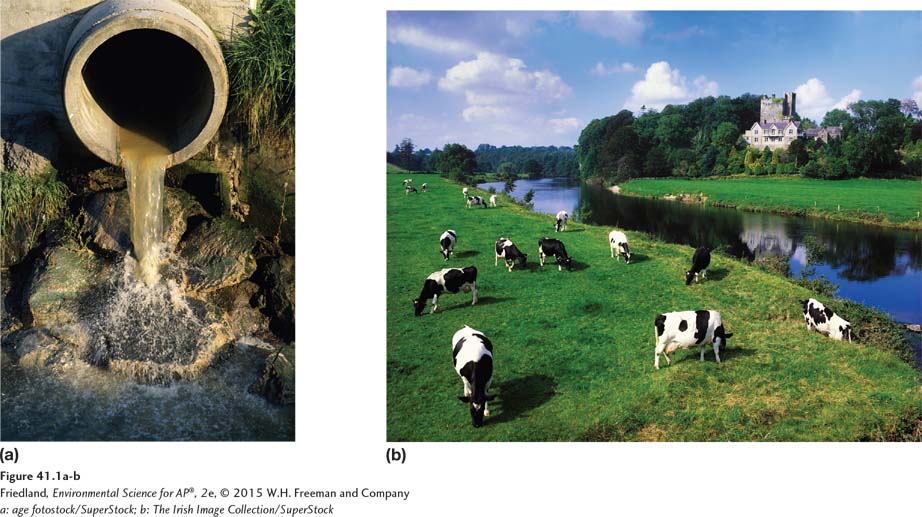
Environmental scientists are concerned about wastewater as a pollutant for three major reasons. First, wastewater dumped into bodies of water naturally undergoes decomposition by bacteria, which creates a large demand for oxygen in the water. Second, the nutrients that are released from wastewater decomposition can make the water more fertile. Third, wastewater can carry a wide variety of disease-
Oxygen Demand
Biochemical oxygen demand (BOD) The amount of oxygen a quantity of water uses over a period of time at specific temperatures.
When organic matter enters a body of water, microbes that are decomposers feed on it. Because these microbes require oxygen to decompose the waste, the more waste that enters the water, the more the microbes grow and the more oxygen they demand. The amount of oxygen a quantity of water uses over a period of time at a specific temperature is its biochemical oxygen demand (BOD). Lower BOD values indicate that a water body is less polluted by wastewater, and higher BOD values indicate that a water body is more polluted by wastewater. If we were to test the BOD of natural waters over a 5-
Dead zone In a body of water, an area with extremely low oxygen concentration and very little life.
When microbial decomposition uses a large amount of oxygen in a body of water, the amount of oxygen remaining for other organisms can be very low. Low oxygen concentrations are lethal to many organisms including fish. Low oxygen can also be lethal to organisms that cannot move, such as many plants and shellfish. Some areas, known as dead zones, become so depleted of oxygen that little life survives. Dead zones can be self-
Nutrient Release
Eutrophication A phenomenon in which a body of water becomes rich in nutrients.
Cultural eutrophication An increase in fertility in a body of water, the result of anthropogenic inputs of nutrients.
When wastewater decomposes it releases nitrogen and phosphorus. As you may recall from Chapter 3, nitrogen and phosphorus are generally the two most important elements for limiting the abundance of producers in aquatic ecosystems. The decomposition of wastewater releases nitrogen and phosphorus, which in turn provide an abundance of fertility to a water body, a phenomenon known as eutrophication. As noted at the beginning of this chapter, the Chesapeake Bay experiences eutrophication from wastewater decomposition as well as from nutrients leached from fertilized agricultural lands during precipitation. When a body of water experiences an increase in fertility due to anthropogenic inputs of nutrients, it is called cultural eutrophication.
Eutrophication initially causes a rapid growth of algae, known as an algal bloom. As we discussed in Chapter 3, this enormous amount of algae eventually dies and microbes then rapidly begin digesting the dead algae; the increase in microbes consumes most of the oxygen in the water (see FIGURE 7.5 on page 88). In short, the release of nutrients from wastewater initiates a chain of events that eventually leads to a lack of oxygen and the creation of dead zones once again. One of the most impressive dead zones in the world occurs where the Mississippi River dumps into the Gulf of Mexico, shown in FIGURE 41.2a. The Mississippi River receives water from 41 percent of the land of the continental United States. Each summer there is an influx of wastewater and fertilizer that causes large algal blooms followed by substantial decreases in oxygenated water and massive die-
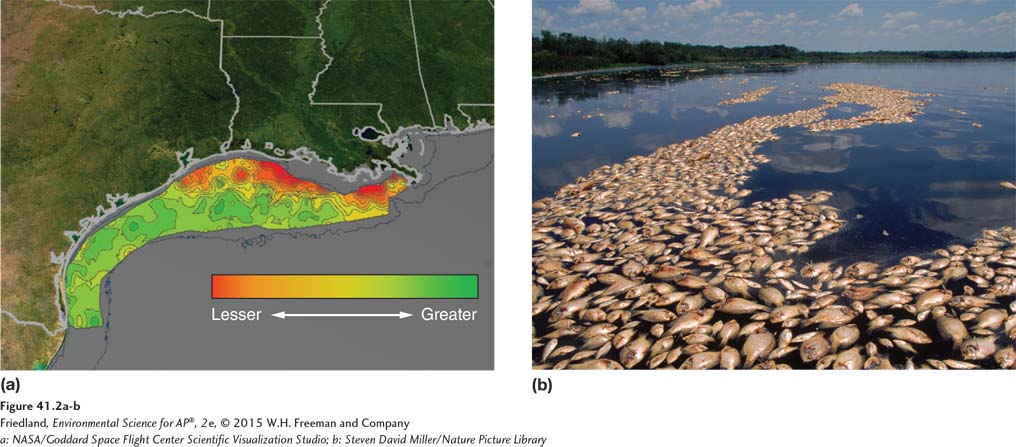
Disease-
For centuries, humans have faced the challenge of keeping wastewater from contaminating drinking water. This can be difficult because throughout the world many people routinely use the same water source for drinking, bathing, washing, and disposing of sewage (FIGURE 41.3). Wastewater can carry a variety of pathogens including viruses, bacteria, and protists. Pathogens in wastewater are responsible for a number of diseases that can be contracted by humans or other organisms coming in contact with or ingesting the water. Such pathogens cause cholera, typhoid fever, various types of stomach flu, and diarrhea.
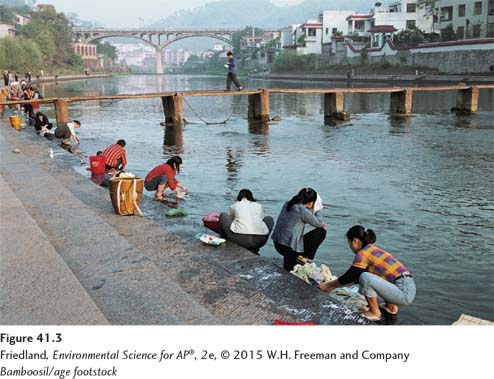
Worldwide, the major waterborne diseases are cholera and hepatitis. Cholera, which claims thousands of lives annually in developing countries (FIGURE 41.4), is not common in the United States. However, hepatitis A is appearing more frequently in the United States, usually originating in restaurants that lack adequate sanitation practices. The bacterium Cryptosporidium has caused a number of outbreaks of gastrointestinal illness in this country. Large-

The World Health Organization estimates that 1.1 billion people, nearly one-
Indicator species A species that indicates whether or not disease-
Fecal coliform bacteria A group of generally harmless microorganisms in human intestines that can serve as an indicator species for potentially harmful microorganisms associated with contaminated sewage.
Because of the risk that pathogens pose, we need the ability to easily test for the presence of pathogens in our drinking water. It is not feasible to test for all of the many different pathogens that can exist in drinking water. Instead, scientists have settled on using an indicator species, an organism that indicates whether or not disease-
Public water supplies, such as drinking water sources and swimming pools, are routinely tested for E. coli. Homeowners with a single-
We have technologies to treat wastewater
Because proper sanitation is so important, we need ways of treating wastewater to reduce the risk of waterborne pathogens. Humans have devised a number of ways to handle wastewater. The various solutions all have the same basic approach: Bacteria are used to break down the organic matter into carbon dioxide and inorganic compounds, which include nitrogen and phosphorus, and the harmful pathogens are outcompeted by nonharmful pathogens. In this section we will look at the two most widespread systems for treating human sewage: septic systems and sewage treatment plants. We will also describe manure lagoons, which are used to treat waste from large livestock operations.
Septic Systems
Septic system A relatively small and simple sewage treatment system, made up of a septic tank and a leach field, often used for homes in rural areas.
Septic tank A large container that receives wastewater from a house as part of a septic system.
Sludge Solid waste material from wastewater.
Septage A layer of fairly clear water found in the middle of a septic tank.
In rural areas, houses often treat their own sewage with a septic system, which is a relatively small and simple sewage treatment system that is made up of a septic tank and a leach field. Septic systems are often used for homes in rural areas. As shown in FIGURE 41.5, the septic tank is a large container that receives wastewater from the house. Having a capacity of 1,900 to 4,700 L (500–
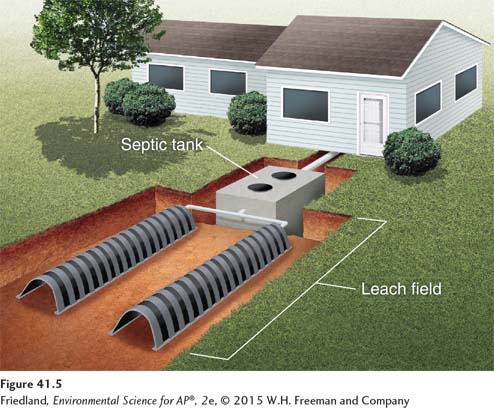
Leach field A component of a septic system, made up of underground pipes laid out below the surface of the ground.
Through gravity, septage moves out of the septic tank into several underground pipes laid out across a lawn below the surface. The combination of pipes and lawn makes up the leach field. The pipes contain small perforations so the water can slowly seep out and spread across the leach field. The septage that seeps out of the pipes is slowly absorbed and filtered by the surrounding soil. The harmful pathogens in the septage can be outcompeted by other microorganisms in the septic tank and therefore diminish in abundance, or can be degraded by soil microorganisms after the septage seeps out into the leach field. The organic matter found in the septage is broken down into carbon dioxide and inorganic nutrients. Eventually, the water and nutrients seeping out into the leach field are taken up by plants or enter a nearby stream or aquifer.
There are significant environmental advantages to septic systems. Because most septic systems rely on gravity—
Sewage Treatment Plants
Although household septic systems work well for rural areas in which each house has sufficient land for a leach field, they are not feasible for more developed areas with greater population densities and little open land. In developed countries, municipalities use centralized sewage treatment plants that receive the wastewater from hundreds or thousands of households via a network of underground pipes. In a traditional sewage treatment plant, wastewater is handled using a primary treatment followed by a secondary treatment.
As shown in FIGURE 41.6, the primary treatment allows the solid waste material to settle into a sludge layer. The remaining wastewater undergoes a secondary treatment that uses bacteria to break down 85 to 90 percent of the organic matter and convert it into carbon dioxide and inorganic nutrients such as nitrogen and phosphorus. The secondary treatment typically aerates the water to add oxygen; this promotes the growth of aerobic bacteria, which emit less offensive odors than anaerobic bacteria. The treated water sits for several days to allow particles to settle out. Settled particles are added to the sludge from the primary treatment. The remaining water is disinfected, using chlorine, ozone, or ultraviolet light to kill any remaining pathogens. The disinfected water is then released into a nearby river or lake, where it is once again part of the global water cycle.
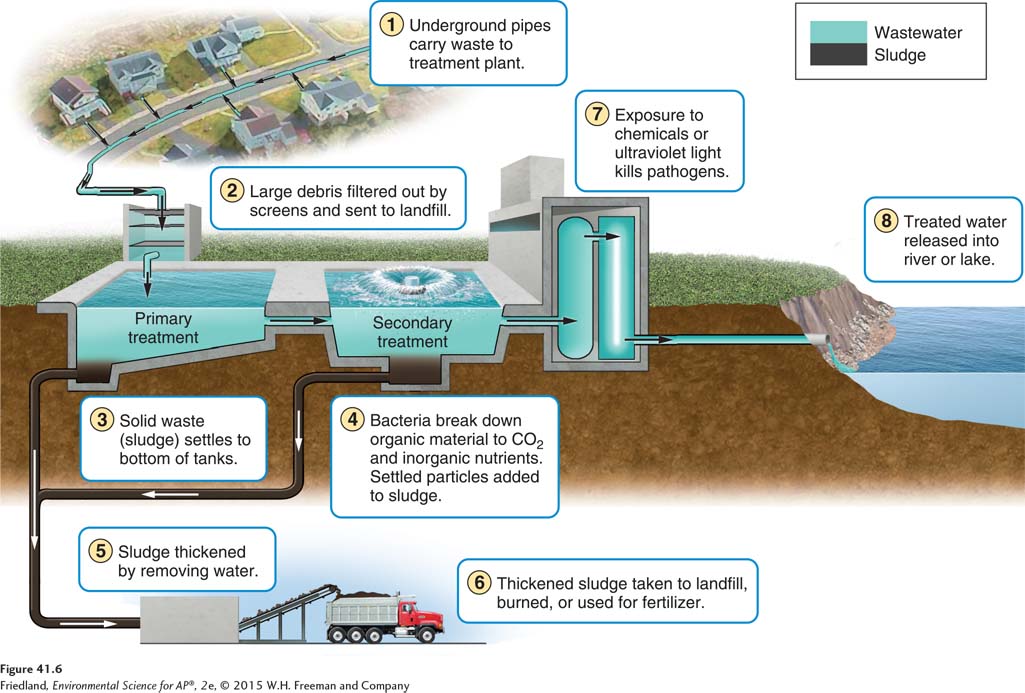
The combined sludge from the primary and secondary treatments must be taken away from the sewage treatment plant. To reduce the volume of material prior to transport and help remove many of the pathogens, sludge is typically exposed to bacteria that can digest it. After digestion, most of the water is removed from the sludge, which reduces its volume and weight. This final form of sludge can be placed into a landfill, burned, or converted into fertilizer pellets for agricultural fields, lawns, and gardens.
Sewage treatment plants are very effective at breaking down the organic matter into carbon dioxide and inorganic nutrients. Unfortunately, these inorganic nutrients can still have undesirable effects on the waterways into which they are released. Although nitrogen and phosphorus are important nutrients for increasing primary productivity, when high concentrations of these nutrients are released into bodies of water from sewage treatment plants, they fertilize the water, which can lead to large increases in the abundance of algae and aquatic plants. In response to this problem, large sewage treatment plants are now developing tertiary treatments that remove nitrogen and phosphorus from the wastewater. The ultimate goal is to release wastewater that is similar in quality to the water body that is receiving it.
Legal Sewage Dumping
Sewage treatment plants are critical to human health because they remove a great deal of harmful organic matter and associated pathogens that cause human illness. It might surprise you to know that even in the most developed countries, raw sewage can sometimes be directly pumped into rivers and lakes. Sewage treatment plants are typically built to handle wastewater from local households and industries. However, many older sewage treatment plants also receive water from stormwater drainage systems. During periods of heavy rain, the combined volume of storm water and wastewater overwhelms the capacity of the plants. When this happens, the treatment plants are allowed to bypass their normal treatment protocol and pump vast amounts of water directly into an adjacent body of water.
How big a problem is this? According to the U.S. Environmental Protection Agency, overflows of raw sewage occur approximately 40,000 times per year in the United States. In Indianapolis, for example, more than 3.8 billion liters (1 billion gallons) of raw sewage are dumped into surrounding water bodies each year during periods of high rain. Around the country, such incidents result in the contamination of drinking water, beaches, fish, and shellfish, and can lead to human illness. Between 1.8 million and 3.5 million illnesses are associated with swimming in sewage-
Animal Feed Lots and Manure Lagoons
Although the impact of human waste on the environment and human health is generally understood, people are less familiar with the problem of animal waste. On a small scale, animal manure can contaminate waters when farm animals are allowed access to streams for food and water because, inevitably, they will defecate in the stream. As you may recall from Chapter 11, large-
Manure lagoon Human-
Farms that raise thousands of animals in a single location often use a manure lagoon to dispose of the tremendous amount of manure produced (FIGURE 41.7). A manure lagoon is a large, human-
